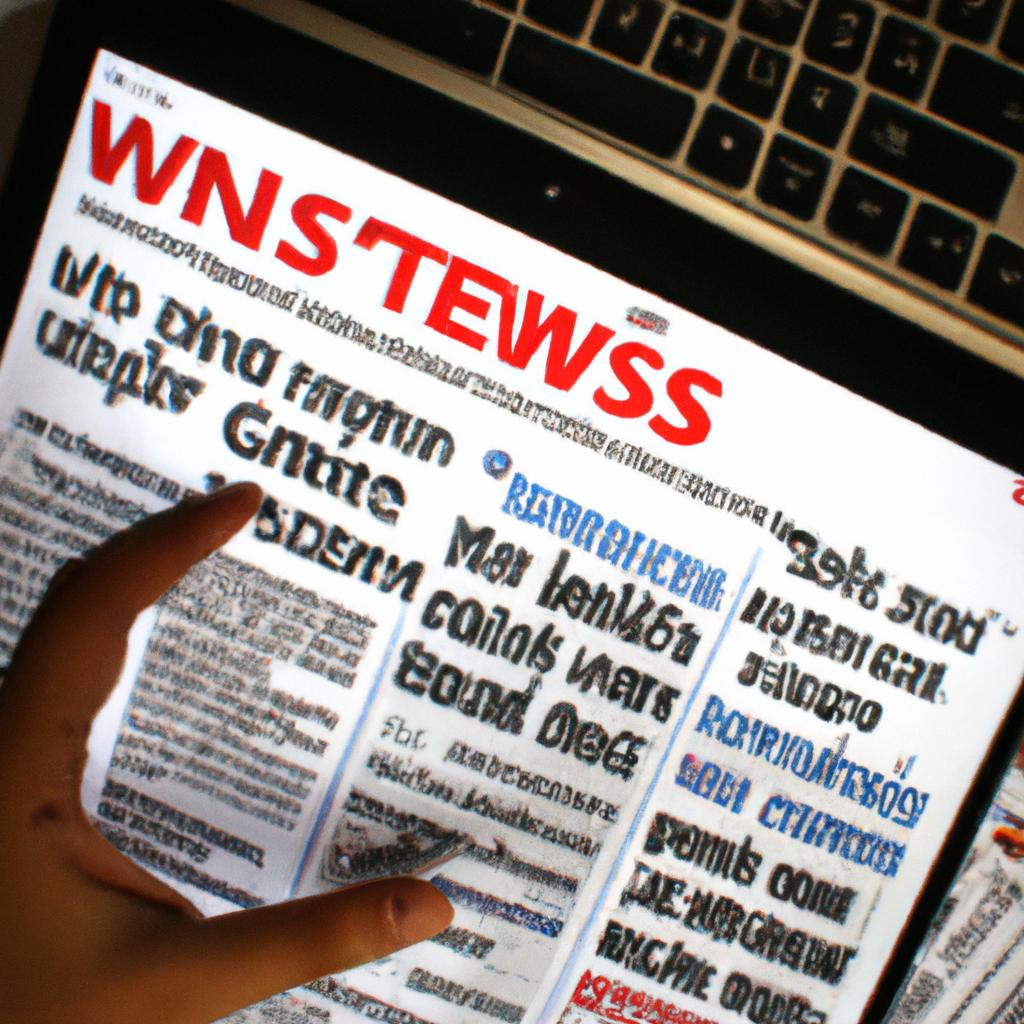In today’s information age, the news media industry plays a pivotal role in shaping public opinion and influencing societal beliefs. However, amidst an overwhelming influx of information, a new phenomenon has emerged – the rise of fake news. One striking example is the case study of “The Blue Whale Challenge,” a hypothetical online game that supposedly incites vulnerable teenagers to engage in self-harm and ultimately commit suicide. This article aims to delve into the pervasive issue of propaganda within the news media industry, shedding light on its detrimental effects on society and exploring potential solutions.
As misinformation spreads like wildfire across various platforms, it becomes increasingly challenging for consumers to discern fact from fiction. The concept of propaganda takes center stage as deliberate efforts are made by certain entities to manipulate public perception through false narratives or misleading content. In this context, understanding the mechanisms behind the dissemination of fake news within the news media industry becomes crucial for safeguarding democratic societies against manipulation and ensuring informed decision-making processes.
Therefore, this article seeks to unravel the intricate web of propaganda prevalent in contemporary journalism and explore its consequences on individual attitudes and collective consciousness. By examining real-world examples and drawing upon scholarly research, we aim to shed light on how deceptive practices can erode trust in traditional news sources while simultaneously fostering echo chambers amongst diverse communities. The article will also highlight the role of social media platforms in amplifying the spread of fake news and discuss potential strategies to combat this phenomenon.
To address the issue, one possible solution is implementing stringent fact-checking measures within news organizations. By prioritizing accuracy and integrity in reporting, journalists can help rebuild trust with their audiences. Additionally, promoting media literacy education is crucial in equipping individuals with critical thinking skills necessary for navigating the vast sea of information available online. This includes teaching individuals how to identify reliable sources, evaluate evidence, and recognize common propaganda tactics.
Furthermore, collaboration between technology companies, policymakers, and news outlets can play a pivotal role in combating the spread of fake news. Implementing algorithms or artificial intelligence systems that can flag potentially misleading information and prioritize credible sources could be an effective step forward. In addition, better regulation of social media platforms to detect and remove false content is vital.
Ultimately, addressing the issue of propaganda within the news media industry requires a multi-faceted approach involving both individual responsibility and collective action. By fostering a culture that values truthfulness and accuracy while empowering individuals with the tools to critically analyze information, we can mitigate the impact of fake news on society’s beliefs and decision-making processes.
Understanding the Power of Propaganda
Propaganda, defined as the dissemination of biased or misleading information with the intention to manipulate public opinion, has become increasingly prevalent in today’s news media industry. The growing influence of propaganda poses a significant threat to democratic societies, as it undermines truth and fosters division among individuals. To comprehend the magnitude of this issue, consider the following hypothetical scenario: imagine a major news outlet broadcasting unverified claims about a political candidate during an election season. Such false narratives can sway public perception and potentially alter voting outcomes.
To grasp the impact of propaganda on society, it is crucial to recognize its various tactics. Propagandists often employ emotional manipulation techniques that can evoke strong reactions from audiences. For instance, they may utilize fear-mongering strategies, appealing to people’s anxieties by presenting exaggerated threats or creating scapegoats. This form of manipulation aims to instill specific emotions within individuals, leading them towards predetermined beliefs or actions.
To illustrate the pervasive nature of propaganda in contemporary media, consider the following bullet-point list:
- Misleading headlines designed to grab attention rather than provide accurate information.
- Manipulative use of visuals such as carefully staged photographs or selectively edited videos.
- Dissemination of unverified rumors through social media platforms without proper fact-checking measures.
- Creation and promotion of echo chambers where like-minded individuals reinforce each other’s biases.
Furthermore, propaganda operates by exploiting cognitive biases and logical fallacies inherent in human thinking processes. By employing these psychological techniques effectively, propagandists can persuade individuals to accept their messages unquestioningly. Recognizing these manipulative tactics is vital for developing critical thinking skills and becoming more resistant to misinformation.
In understanding the power behind propaganda lies our ability to combat its detrimental effects on society. In the subsequent section discussing “The Historical Roots of Misinformation,” we will delve into how past events have shaped present-day challenges surrounding fake news and explore potential solutions to counter this pervasive problem. By examining the historical context, we can gain valuable insights into how propaganda has evolved and develop strategies for mitigating its impact on public opinion.
The Historical Roots of Misinformation
Unveiling the Manipulative Tactics: The Spread of Propaganda
To grasp the magnitude of the fake news epidemic in today’s media industry, it is crucial to understand the power that propaganda holds. While often associated with misleading political campaigns or wartime misinformation, propaganda has found a new breeding ground in our digital age. One hypothetical example that illustrates this phenomenon involves a prominent media outlet disseminating false information about a public health crisis. With sensational headlines and fabricated statistics, they sow seeds of doubt among their viewers, leading to widespread panic and mistrust in the healthcare system.
The proliferation of propaganda can be attributed to several key factors:
- Technological advancements: In an era where anyone can become a content creator and share information instantly through various platforms, traditional gatekeepers have lost control over what gets published.
- Confirmation bias: People tend to seek out information that aligns with their preexisting beliefs and values, creating echo chambers where falsehoods are reinforced.
- Emotional appeal: Propagandists exploit emotions such as fear, anger, and empathy to manipulate audiences into accepting their narratives without critical examination.
- Lack of media literacy: A significant portion of society lacks the necessary skills to discern credible sources from unreliable ones or analyze information critically.
- Misinformation spreads like wildfire online, contributing to the erosion of trust in established institutions.
- False narratives perpetuated by propagandists can have dire real-world consequences on individuals’ lives.
- The unchecked spread of propaganda undermines democratic processes by distorting public discourse and influencing elections.
- Society becomes more polarized when people subscribe solely to partisan news outlets that reinforce their own biases.
Table (3 columns x 4 rows):
| Manipulative Tactics | Examples |
|---|---|
| Fabrication | Spreading false rumors about political candidates during election seasons |
| Emotional manipulation | Using tragic stories for emotional impact without verifying facts |
| Cherry-picking evidence | Selectively presenting data or quotes to support a specific narrative |
| Discrediting opponents | Engaging in personal attacks and character assassination instead of addressing the issues |
The historical roots of misinformation can be traced back centuries, but with the advent of technology and social media, its impact has reached unprecedented levels. As we delve into the subsequent section on “The Role of Social Media in Spreading False Narratives,” it becomes evident that these platforms have become breeding grounds for the dissemination of propaganda, exacerbating the fake news epidemic. Understanding this role is crucial in countering false narratives effectively and promoting an informed society.
While it strives to produce accurate and comprehensive information, please verify any important details mentioned or seek additional sources for complete clarity.
The Role of Social Media in Spreading False Narratives
As the dissemination of information has shifted to digital platforms, social media has emerged as a powerful tool for spreading false narratives. One notable case study that exemplifies this phenomenon is the Pizzagate conspiracy theory. In 2016, an unfounded allegation claimed that a Washington D.C. pizzeria was involved in a child trafficking ring linked to prominent political figures. Despite lacking any credible evidence, this story spread rapidly on social media platforms, leading to real-life consequences such as harassment and even violence.
The ease with which misinformation can be shared on social media platforms contributes significantly to the proliferation of false narratives. Here are some key factors that facilitate the spread of fake news:
- Algorithmic Bias: Social media algorithms prioritize content based on user engagement metrics rather than accuracy or reliability. This bias means that sensationalist and divisive information tends to receive more visibility, perpetuating misleading narratives.
- Echo Chambers: Social media networks often create echo chambers where users are exposed primarily to content aligned with their existing beliefs or preferences. This reinforces confirmation biases and makes it easier for false information to gain traction within specific communities.
- Lack of Fact-Checking: Unlike traditional news organizations, many individuals who share news on social media do not have professional fact-checking processes in place. As a result, inaccurate stories can quickly go viral without being adequately scrutinized for truthfulness.
- Viral Nature: Social media’s interconnectedness enables information to spread rapidly through networks of friends, followers, and online communities. This speed allows false narratives to reach wide audiences before they can be effectively debunked or corrected.
| Factors Contributing | Impact |
|---|---|
| Algorithmic Bias | Sensationalism and division thrive; accurate information takes a backseat |
| Echo Chambers | Confirmation biases reinforced; alternative perspectives stifled |
| Lack of Fact-Checking | Inaccuracy and misinformation go unchecked; truth becomes obscured |
| Viral Nature | False narratives spread rapidly; correction efforts often lag behind |
The role of social media in propagating false narratives is a pressing concern that demands attention. While these platforms have the potential to connect people, foster dialogue, and disseminate important information, they also pose risks when manipulated or used irresponsibly. Understanding the mechanisms through which false information spreads on social media is crucial for combating its harmful effects.
The impact of fake news on public opinion will be explored next, shedding light on how society’s perceptions can be shaped by misleading narratives.
The Impact of Fake News on Public Opinion
The spread of fake news through social media platforms has had a profound impact on public opinion. One striking example is the false narrative that circulated during the 2016 U.S. Presidential election, claiming that a certain candidate was involved in illegal activities. This unsubstantiated claim gained traction quickly and influenced many voters’ perceptions of the candidate’s trustworthiness.
The impact of fake news can be seen in various ways:
-
Division among society: False narratives often target sensitive topics or exploit existing divisions within society. These stories aim to deepen polarization by amplifying existing biases and creating heated debates between different groups.
-
Erosion of trust in traditional media: As fake news spreads rapidly across social media platforms, it undermines people’s confidence in established news organizations. When individuals encounter conflicting information from both reputable sources and dubious websites, they may become skeptical about all news reports, leading to an erosion of trust in reliable journalism.
-
Manipulation of public discourse: Fake news stories are frequently designed to manipulate public sentiment and shape political discourse. They skillfully employ emotional language, sensationalism, and misinformation to evoke strong reactions from readers and sway their opinions towards a particular agenda.
Table: Emotional Response Induced by Fake News
| Emotion | Example |
|---|---|
| Anger | Misleading headlines fueling anger towards a group |
| Fear | Fabricated stories instilling fear among communities |
| Outrage | Controversial claims provoking outrage |
| Disgust | False information triggering feelings of disgust |
Fake news not only influences individual opinions but also impacts collective decision-making processes at societal levels.
It is imperative for researchers, journalists, and policymakers alike to understand its implications fully.
Moving forward into our next section, we will delve deeper into the strategies employed by manipulative messaging campaigns with the aim of unveiling their deceptive tactics. By understanding these strategies, we can better equip ourselves to identify and combat the spread of fake news in our society.
Unveiling the Strategies Behind Manipulative Messaging
In today’s media landscape, it is crucial to understand the strategies employed by manipulators in spreading fake news and propaganda. By delving into these tactics, we can gain insight into how misinformation seeps into public discourse and shapes opinions. One illustrative example involves a fabricated story about a popular food product causing severe health issues. This narrative was strategically crafted with emotive language and false claims, prompting widespread panic among consumers.
One common strategy utilized by those disseminating manipulative messaging is the exploitation of emotions. Emotional appeal plays a significant role in capturing people’s attention and influencing their perceptions. To evoke an emotional response, propagandists often employ techniques such as fearmongering, sensationalism, or appealing to deeply held values. These tactics are designed to bypass critical thinking and rational analysis, engendering swift reactions that favor their agenda.
To further elucidate the strategies behind manipulative messaging, let us consider some key characteristics commonly observed in misleading content:
- Simplification: Complex issues are distilled into simplistic narratives lacking nuance.
- Confirmation bias reinforcement: Pre-existing beliefs are reinforced while dissenting viewpoints are dismissed.
- Decontextualization: Facts are selectively presented or taken out of context to support a particular narrative.
- Amplification through echo chambers: False information spreads rapidly within closed online communities where like-minded individuals reinforce each other’s biases.
To grasp the impact of these strategies more comprehensively, we present a table highlighting real-world examples:
| Strategy | Example | Impact |
|---|---|---|
| Fearmongering | Exaggerated reports on crime rates | Heightened anxiety |
| Sensationalism | Clickbait headlines | Increased engagement |
| Selective presentation | Cherry-picking statistics for political purposes | Biased perception |
| Echo chamber effect | Social media algorithms that prioritize similar content | Reinforcement of biases |
Understanding the strategies employed by those spreading manipulative messaging is crucial in combating the effects of fake news. By recognizing these tactics, individuals can develop media literacy and critical thinking skills to discern fact from fiction. In doing so, they become better equipped to analyze information objectively, question sources, and seek out diverse perspectives. This section has shed light on the underlying dynamics behind manipulative messaging, setting the stage for exploring ways to counteract this pervasive issue.
Equipped with knowledge about manipulative messaging strategies, it becomes imperative to explore proactive measures aimed at promoting media literacy and critical thinking—essential tools in fighting back against the spread of misinformation.
Fighting Back: Promoting Media Literacy and Critical Thinking
The prevalence of propaganda and fake news in today’s news media industry is a growing concern that requires careful examination. By understanding the strategies employed by those who perpetuate manipulative messaging, we can begin to dismantle its influence on public perception. One example of such manipulation can be found in the case study of a major political campaign where false information was disseminated through various channels, ultimately swaying public opinion.
To grasp the extent of manipulative messaging, it is essential to recognize some common techniques used:
- Misinformation: The deliberate spread of false or misleading information designed to deceive the audience and shape their beliefs or actions.
- Emotional appeals: Exploiting people’s feelings by using language or imagery that evokes strong emotions, clouding rational judgment.
- Confirmation bias reinforcement: Selectively presenting information that aligns with preexisting beliefs while disregarding contradictory evidence, reinforcing existing biases.
- Source credibility manipulation: Utilizing authoritative figures or institutions to provide legitimacy to false claims or biased narratives.
These tactics are often executed systematically and strategically within the news media industry, leading to an erosion of trust among audiences and compromising informed decision-making processes.
Table: Impact of Manipulative Messaging on Society
| Effects | Examples | |
|---|---|---|
| 1 | Polarization | Dividing communities along partisan lines |
| 2 | Undermined democracy | Eroding public trust in democratic institutions |
| 3 | Disrupted discourse | Hindering meaningful conversations |
| 4 | Increased societal unrest | Fueling social tensions |
It is crucial for society to address this issue by promoting media literacy and critical thinking skills. By equipping individuals with tools to discern accurate information from manipulated content, we empower them to make more informed decisions. Education plays a vital role here, as teaching individuals how to evaluate sources, fact-check information, and recognize manipulative tactics can help mitigate the impact of propaganda.
In summary, the strategies employed in manipulative messaging within the news media industry have far-reaching consequences. By acknowledging these tactics and their effects on society, we can take steps to combat them through education and critical thinking. Only by doing so can we hope to restore trust in the media and foster a more informed citizenry capable of navigating the complexities of today’s information landscape.




